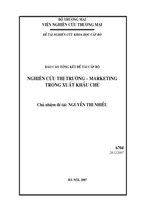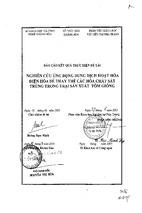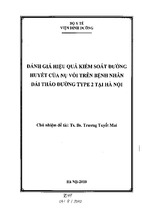THE IMPACT OF CORPORATE SOCIAL RESPONSIBILITY (CSR) ON THE
COMPANY’S FINANCIAL PERFORMANCE
BY
CHU MAI LY
Graduation Project Submitted to the Department of Business Studies,
HELP University College, in Partial Fulfilment of the Requirements for
the Degree of Bachelor of Business (Accounting) Hons
Octorber 2011
1
DECLARATION OF ORIGINALITY AND WORD COUNT
I hereby declare that the graduation project is based on my original work except for
quotations and citations which have been duly acknowledged. I also declare that it has
not been previously or concurrently submitted for any other course/degree at HELP
University College or other institutions. The word count is 9,875 words.
_____________________
NAME OF CANDIDATE
Date:
2
Acknowledgement
This project would not have been made possible without the assistance, support and
encouragement of many people. I wish to take this opportunity to thank all the people
who have helped me during the time of completing the dissertation. I would like to
express gratitude towards Dr. Pham Duc Hieu and Dr. Le Van Lien and to Ms Shumathi
for their support and guidance. I would also thank some my friends for their financial
support for this project.
3
THE IMPACT OF CORPORATE SOCIAL RESPONSIBILITY (CSR) ON THE
COMPANY’S FINANCIAL PERFORMANCE
By
CHU MAI LY
Octorber 2011
Supervisor: Dr. PHAM DUC HIEU
Abstract
Does CSR impact on firms' profits? CSR will lead to increase or decrease of financial
performance of the firms. Firms face complex market conditions, external effects and
asymmetric information which may lead to market failure and sub‐optimal profits. In the
literature, market failures could build the theoretical base for corporate social
responsibility (CSR) implementation by firms. In fact, firms in competitive markets
could use CSR as a management tool to gain more profits through diversification.
Further, the implementation of CSR requires the detection of future trends and
developments which makes the firms more stable to sudden events. Therefore, CSR may
offer firms the opportunity to gain higher profits than they would get without CSR.
Alternatively, CSR could lead to higher costs and thus to worse financial performance.
Many studies are taken in which the method of study is quantitative or using the KLD
data base. In this study, I will examine the relationship of CSR and financial
performance in a different view and different method. This study makes clear
relationship in the aspect of identifying the costs and benefits of CRS, how those costs
and benefits will affect the accounting earnings or profits of the firms. Those issues will
be improved by the case of Vedan and Miwon in Vietnam.
4
TABLE OF CONTENTS
Page
Declaration of Originality and word count
ii
Acknowledgement
iii
Abstract
iv
Table of Content
v
CHAPTER 1
INTRODUCTION
1.1
Background of study
1.2
Statement of purpose
1.3
Structure of study
7
8
8
9
Chapter 2
LITERATURE REVIEW
2.1
The history of CSR
2.2
The definition of CSR
2.3
The term of CSR
2.4
Theories describing the CSR/financial performance relationship
2.4.1 The theory suggest positive relationship
2.4.2 Theory suggest a negative relationship
2.5
The link between corporate social performance and corporate financial
performance.
2.6
CSR and accounting performance
2.6.1 Economic benefits of CSR
2.6.2 How economic benefits are reflected in accounting earning
2.6.3 Economic benefits of CSR
2.6.4 How economic costs are reflected on accounting earnings
2.7
Additional accounting issues and implications
10
10
11
13
15
16
19
Chapter 3
29
METHODOLOGIES
3.1
Research objective
3.2
Research strategy
3.2.1 Data resource
3.2.1.1 Secondary data
3.2.2 Qualitative Research
3.3
Measurement
3.3.1 Measurement of Corporate Social Performance
3.3.2 Measurement of financial performance
3.4
Case study
3.4.1 Vedan
3.4.2 Miwon
3.5
Limitations
..
20
22
22
22
24
25
27
29
29
29
29
30
31
31
32
34
34
35
36
5
Chapter 4
4.1
4.1.1
4.1.2
4.1.3
4.1.4
4.2
4.2.1
4.2.2
4.2.3
ANALYSIS
Vedan
Case study of Vedan
Vedan before apply CSR
Vedan after apply CSR
Vedan resolves their problem
Miwon
Case study of Miwon
Miwon before apply CSR
Miwon after apply CSR
36
36
36
37
38
39
40
40
40
41
Chapter 5
CONCLUSIONS
5.1
Summary
5.2
Conclusion
5.3
Recommendation
42
42
43
44
REFERENCES/BIBLIOGRAPHY
45
6
Chapter 1: Introduction
1.1. Background of study
In today‘s society, there is a growing interest in and demand for Corporate Social
Responsibility (CSR). Reasons for this can be multinational corporations‘ increasing
influence on the world economy as well as scandals revealing horrible working
conditions in different industries.
The field of corporate social responsibility has grown exponentially in the last decade.
More than half of the Fortune 1000 companies issue corporate social responsibility
(CSR) reports. A larger number of companies than at any time before are now engaged
in serious efforts to define and integrate CSR into all aspects of their businesses. An
increasing number of shareholders, analysts, regulators, activists, labor unions,
employees, community organizations, and news media are asking companies to be
accountable for an ever-changing set of CSR issues. There is increasing demand for
transparency and growing expectations that corporations measure, report, and
continuously improve their social, environmental, and economic performance.
Corporate social responsibility is not a new issue. According to Business for Social
Responsibility (BSR), corporate social responsibility is defined as ―achieving
commercial success in ways that honor ethical values and respect people, communities,
and the natural environment.‖ McWilliams and Siegel (2001:117) describe CSR as
―actions that appear to further some social good, beyond the interest of the firm and that
which is required by law.‖ A point, which is worth noticing, is that CSR is more than
just following the law (McWilliams & Siegel, 2001). Alternatively, according to
Frooman (1997:227), the definition of what would exemplify CSR is the following: ―An
7
action by a firm, which the firm chooses to take, that substantially affects an identifiable
social stakeholder‘s welfare.‖ A socially responsible corporation should take a step
forward and adopt policies and business practices that go beyond minimum legal
requirements and contribute to its key stakeholders‘ welfare. CSR is viewed and then, a
comprehensive set of policies, practices, and programs is integrated into business
operations, supply chains, and decision-making processes throughout the company and
usually includes issues related to business ethics, community investment, environmental
concerns, governance, human rights, the marketplace as well as the workplace.
1.2. Statement of purpose
This thesis tries to find out the impact of CSR on the company‘s financial performance
but does not focus on why and how firms behave socially responsible. The relationship
between CSR and firms‘ accounting performance will be thoroughly analyzed to
estimate impacts of CSR policy changes. Additionally, costs and benefits of CRS are
also accounted for. One other interesting question is raised that whether CSR can
increase profit of the company and after reading and researching, two Vietnamese
companies are selected: Miwon and Vedan, which are the outcome of adopted CSR.
In order to analyze the question ―what is the impact of CSR on the company‘s
profitability?‖ the project is divided into five parts:
What is the CSR?
-
The definition of CSR
-
The theories of CSR
What is the finance performance?
8
What is the relationship between CSR and finance performance?
The role of CSR to increase profit of the company.
The outcome of adopted CSR in Vedan and Miwon in Vietnam
1.3. Structure of Study
The thesis will be divided to main parts:
Chapter 2 provides some basic understandings about CSR; the relevant theories
describe the relationship between CSR and finance performances as well as empirical
studies of CSR and financial performances. The relevant theories will be examined in
two aspects of positive and negative relationship. Chapter 2 also discusses three main
problems of CSR: The link between corporate social performances and corporate
financial performances, how CSR affects accounting performances, and additional
accounting issues and implications. The framework for the subsequent analysis will be
created from this chapter.
Chapter 3 discusses about the relationship between CSR and financial performance of
the firm and it will be presented and analyzed according to the literature review.
Chapter 4 also analyses the outcome of CSR adopted by Vedan and Miwon in Vietnam.
Chapter 5 recaps the study and provides concluding remarks.
9
Chapter 2: Literature review
At this point in history, as globalization surges on while technology continues to shift
the foundations of economic reality at local, national, and international levels, ushering
in new challenges to all firms and governments and blurring traditional distinctions
among social institutions, it is critical to examine the notion of Corporate Social
Responsibility (CSR).
2.1. The history of CSR
Since 1960s when CSR is initially mentioned, its nature has changed several times. Until
now, the concept of CSR is also redefined and becomes a new definition. However,
unlike the economic, legal and ethical expectations placed on organizations varies from
societies to societies, all societies in the world at any period of their development have
some similar expectations about what organizations should act under their social
responsibilities.
In the eighteenth century, the great economist and philosopher Adam Smith partly
expressed the CRS in his economic research. He concluded that market participants must
act honestly, a form of CRS, to reach the ideal situation of the free market. His theory
was espoused by many new principles contributed by the Industrial Revolution in the
nineteenth century, when many huge organizations were developed. Those
organizations, however, were not aware of the importance of CRS and did not act in a
proper way for social welfare.
Hence, in twentieth century, there is a backlash against the large corporations was
appearance. They were criticized as being too powerful, creating monopoly markets and
10
practicing socially irresponsible policies. Consequently, laws and regulations were
enacted to regulate those large organizations, reduce their power and protect employees,
consumers, and society. The labor movement also occurred to require a greater social
responsibility in business activities. As a result of it, all businesses over the world began
to gradually increase their social responsibilities further rather than pursuit the highest
profit with impacts on social welfare.
In the 1960s and 1970s the civil rights movement, consumerism, and environmentalism
changed society's expectations about organizations' activities. They required the large
organizations must have large responsibilities and contribute more to reduce social
problems and engage in solving them. Many governments issued legal mandates related
to employees‘ rights, product safety, working condition and environmental protection.
They were the first bricks to build up the modern concept of CSR today, which refers
that corporations should aim towards the new goal above their current economic goal
and legal responsibilities to contribute to the betterment of society.
2.2. The definition of CSR
The definition of corporate social responsibility is not abstruse. According to Business
for Social Responsibility (BSR), corporate social responsibility is defined as ―achieving
commercial success in ways that honor ethical values and respect people, communities,
and the natural environment.‖ McWilliams and Siegel (2001:117) describe CSR as
―actions that appear to further some social good, beyond the interest of the firm and that
which is required by law.‖ A point worth noticing is that CSR is more than just
following the law (McWilliams & Siegel, 2001). Alternatively, according to Frooman
(1997:227), the definition of what would exemplify CSR is the following: ―An action by
11
a firm, which the firm chooses to take, that substantially affects an identifiable social
stakeholder‘s welfare.‖ A socially responsible corporation should take a step forward
and adopt policies and business practices that go beyond the minimum legal
requirements and contribute to the welfare of its key stakeholders. CSR is viewed, then,
as a comprehensive set of policies, practices, and programs that are integrated into
business operations, supply chains, and decision-making processes throughout the
company and usually include issues related to business ethics, community investment,
environmental concerns, governance, human rights, the marketplace as well as the
workplace. Each company differs in how it implements corporate social responsibility.
The differences depend on such factors as the specific company‘s size, the particular
industry involved, the firm‘s business culture, stakeholder demands, and how
historically progressive the company is in engaging CSR. Some companies focus on a
single area, which is regarded as the most important for them or where they have the
highest impact or vulnerability—human rights, for example, or the environment—while
others aim to integrate CSR in all aspects of their operations. For successful
implementation, it is crucial that the CSR principles are part of the corporations values
and strategic planning, and that both management and employees are committed to
them. Furthermore, it is important that the CSR strategy is aligned with the company‘s
specific corporate objectives and core competencies. The Dean of Rotman School of
Management, Roger L. Martin (2002), developed the ―virtue matrix‖ as a framework for
how socially responsible behavior enters business practice. The matrix is framed by four
quadrants. The two bottom quadrants include socially responsible conduct in which
corporations engage by choice, by following norms and customs, or by compliance to
existing laws or regulations. Those actions both promote social responsibility and
12
enhance shareholder value. On the other hand, the two top quadrants of the matrix
include the strategic and structural frontiers, which include activities whose value to
shareholders is either clearly negative or not immediately apparent. The boundaries
between the different categories of socially responsible conduct are porous, since a
change in the law or in common practices can cause an activity to migrate from the
upper quadrants to the bottom ones.
2.3. The term of CSR
―CSR has often been criticized for running fast and loose with its concepts‖ (Barnett,
2007). During the first years of the modern CSR concept, some researches indicate that
social responsibility of business has been focused thoroughly but unfortunately, it leaded
to excessive effort in estimating accountability‘s performance. Therefore, Archie B.
Carroll (1979), Professor of University of Georgia, concluded that it was too narrow and
too static to fully describe the social efforts or performance of business. Additionally,
two new terms: Corporate Social Responsiveness (CSR2) and Corporate Social
Performance (CSP) were also defined and emerged during this period. Corporate Social
Responsiveness requires companies to link CSR with strategic management. On the
other hand, Carmen Valor (2005) wrote that Corporate Social Performance probably
builds the managerial framework to deal with CSR and simultaneously measures CSR.
Ackerman and Bauer (1976) were the first researchers provide the differences between
responsiveness and responsibility. In 1994, Frederick defined Corporate Social
Responsiveness as the capacity of a corporation to respond to social pressures and gave
it the popular shorthand name, CSR2. He also described this new term as a conceptual
transition from Moral contemplation to responsive action of Litz (1996): the
13
―philosophical – ethical concept of corporate social responsibility…to the action
oriented managerial concept of corporate social responsiveness‖. It represents ―an effort
to treat as a management issue one which had been predominantly treated as a social
and/or ethical issue‟ (Ackerman and Bauer, 1976).
According to a new definition of corporate social responsiveness, Vallentin, in 2009,
stated that a counterpoint to the principle of CSR now appeared. It was similar to the
argument of Sethi in 1979, which proved that a responsive company was by definition
also responsible and responsiveness was a replacement concept for the old-defined
responsibility. On the other hand, Carroll (1979) obtained the conclusion that
responsibility could not replace by responsiveness because of the conceptual
inadequacy. Responsiveness gives permissions without reflection or responsibility is not
a better reinstatement of a concept of CSR that merely enhances responsibility. It is
possible for a corporation to become responsive and irresponsible.
Following this trend, the Corporate Social Performance (CSP) was defined from the
increasing pragmatic of social and ethical issues. It was emerged as an inclusive and
global approach to appreciate corporate social responsibility, responsiveness and the
entire numbers of socially beneficial business activities. Backhaurs et al (2002)
represented a multidimensional construct of CSP. He viewed CSP as the interaction
between the principles of social responsibility and the processes of social responsiveness
combined with the organizations‘ policies and programs, which are designed to solve
social issues (Watrick and Cochran, 1985).
From Winsor‘s viewpoint (2001), CSP is a broader definition of CSR. CSP conceptually
highlights an improvement in emphasis of obligations and motivations to corporates‘
activities and then operationalizes CSR. CSR contains a redistribution as motivation
14
tools which are generated by moral and ethic principles while CSP involves in the
redistribution processes from firms to public (Barron, 2001). In contrast, Davenport
(2000) criticized that it was just as a theoretical construct from the academic community.
In general, it is still difficult to precisely define the terms CSR, CSR2 and CSP. They are
often used interchangeably. Turban and Grennings (1997) stated that CSP as a firm
accepting responsibility whereas Ullman (1985) gave the nearly identical definitions for
CSR and CSR2, which were related to social demands. Recently, the term ―Corporate
Social Responsibility‖ have been used to refer to not only a firm‘s acceptance of
responsibility but also its actual activities and policies, which have a close relationship
with the Social welfare.
2.4. Theories describing the CSR/financial performance relationship
With the long stream of literature examining the association between corporate social
responsibility and financial performance come a number of theories describing the
relationship. This section provides a summary of the most common theories used to
describe associations between CSR and financial performance. Many of the theories are
similar or overlap to some extent with one another.
A theory suggesting a positive relationship between CSR and financial performance is
stakeholder theory. Stakeholder theory argues that a firm‘s boundary extends beyond the
primary stakeholders to include any group that is affected by, or can affect the
achievement of the firm‘s objectives (Freeman, 1984). Instrumental stakeholder theory
suggests managers ―must induce constructive contributions from their stakeholders‖
(Donaldson and Preston, 1995, pp. 71-72) to achieve organizational goals efficiently. A
hybrid position between normative and instrumental stakeholder theory maintains CSR
15
is will not result in financial performance gains if it is not based on moral principles or is
not genuine (Jones, 1995; Frank 1988). From an agency perspective, stakeholder
relationships act to monitor managerial decision-making and encourage long-term
achievement of organizational goals (Cornell and Shapiro, 1987; Hill and Jones, 1992;
Jones, 1995; Jensen, 2001). Using this reasoning, one would have to assume the cost of
voluntarily engaging in better environmental and/or social performance is less than the
costs that the firm would incur absent any such action. This is similar to what Jensen
(2001) calls ‗enlightened value maximization‘. Jensen states, ―Enlightened value
maximization utilizes much of the structure of stakeholder theory but accepts
maximization of the long run value of the firm as the criterion for making the requisite
tradeoffs among its stakeholders‖ (p. 9, 2011).
2.4.1. The Stakeholder Theory
The importance of stakeholders in terms of CSR was formally recognized by Freeman in
the middle of the 1980. However, its concept seemed to be unclear until 1995,
Donaldson and Preston with their wide range of research paper, classified and
formulated a three-part typology of the theories of stakeholder theory: descriptive,
instrumental and normative. Jones (1995) also supported Donaldson and Preston that the
stakeholder theory answers the following questions: what happens? (Descriptive) What
happens if? (Instrumental) and what should happen? (Normative).
To answer the first question: what happens? (Descriptive), the stakeholder theory
describes corporate characteristics and behaviors and then the corporation is constructed
as a constellation of cooperative and competitive interests over intrinsic values. For
answering the second question: What happens if? (Instrumental), the connection
16
between stakeholder approaches and generally desired objectives of firms such as
profitability, growth and stability will be created. Finally, the question: What should
happen? or a normative theory is used to explain the social function of organizations and
identify their moral and philosophical guidelines for their operation.
Donaldson and Preston also stated that the three theories are closely related to each
other. The general aspect, which possibly considered as the external shell, is the
descriptive theory. It explains the stakeholder relationships inside the firm and will be
supported by the instrumental theory with its forecasting values. Some certain practices
and experiments are necessarily carried out to create the predictions in this level. Lastly,
the central core of the theory is normative, which points out ―what should happen?‖ by
legitimating stakeholder interests and requiring managerial attention as a matter of moral
right.
As earlier definition of instrumental, it is used to make a connection between
stakeholder approaches and commonly desired objectives such as profitability, stability
and growth (Donaldson and Preston, 1995). The nature of Instrumental aspect can be
found in the arguments of General Robert Woods (1950). He represented four parties in
order of importance for every business including customers, employees, community and
shareholders. If the first three parties are cared and their welfare is protected effectively,
the shareholders of the company will benefit as a result. Maintaining the interests of
those groups and receiving their support is the key for the survival of the organization
(The 1963 International memorandum at the Stanford Research Centre).
Post et al (2002) believes that effective and creative stakeholder management is a vital
requirement to stabilize and improve the wealth creating capacity and profitability of the
organization. The stakeholder management is kind of a competitive advantage source. Its
17
evidence is as contracts between organization and stakeholders, which is based on trust
and coordination and therefore less expense are required in monitoring and enforcing
such contracts (Jones, 1995). The failure of the corporate system and its ability to
continue as a going concern can be a result of the failure of remaining the participation
of a primary stakeholder group (Clarkson, 1995).
Similarly, Jarillo (1988) and Jones (1995) cited that the coordinative working relations
with stakeholders would contribute organization success. In reality, stakeholders even
have power to severely affect the continuity of the organization (Freeman, 1984).
However, Orts and Strudler opinion about the instrumental theory in 2002 was different.
They argued that ―the best interests of stakeholders will inevitably also promote the best
interests of shareholders is unreasonably optimistic‖ because of the conflict of interests
and ethics among those stakeholders.
From Hemphill (2004) and Berman and Wicks (1999)‘s argument, an instrumental basis
of the stakeholder theory is perfectly consistent with shareholder theory. It stated that the
last result, after enhancing the first three stakeholders‘ welfare, is the organization could
have nothing to do with the welfare of the last stakeholder group: the shareholders. It is
almost identical to the nature of Friedman‘s view (1970), which proved the social
responsibility of business is to increase its profits. However, those arguments of CSR
above seem to be a bias motivation towards the previous outcome of CSR – increasing
corporation social responsibility for social betterment.
The ultimate clarification for stakeholder theory is possibly found in its normative base.
In order to support the stakeholder theory, Gibson (2000) referred to the theory of
deontology, which represents that individuals have the right to be treated as ends in
themselves and not merely as a means to an end (Shankman, 1999; Metcalfe, 1998).
18
In terms of the theory‘s descriptive aspect, some empirical studies showed that many
managers believe themselves, or are believed by others in operating the organization.
They often did their managerial work without making reference to stakeholder theory.
Donaldson and Preston (1995) argued that the major role of managers adhere in practice
of the core idea of stakeholder theory, which implies that managers‘ role is to satisfy a
wider number of stakeholders, not simply the shareholders. Clarkson (1995) supported
this claim that the strength of stakeholder theory is the precise description if business‘s
function, whose evidence can be found from corporate sources.
Overall, while stakeholder theory has been justified as a descriptive, instrumental and
normative theory, the relationship between CSR and corporate‘s performance is not
merely positive if stakeholders‘ welfare is remained. The trade-off between CSR and
firms‘ performances is also worth to be referred.
2.4.2 Theory suggest a negative relationship
Trade-off theory hypothesizes a negative relationship between CSR and financial
performance. Based on Friedman (1970), this theory views investments as tradeoffs
between stakeholders leading to tradeoffs between profit maximization and socially
responsive objectives (described in Aupperle et al., 1985; Preston and O‘Bannon, 1997).
Corporate social performance, therefore, may lower a firm‘s financial performance
because CSR investments use up resources that could be used in a more profitmaximizing way. Managerial opportunism also suggests a negative relationship between
corporate social performance and financial performance. Preston and O‘Bannon (1997)
were the first to suggest managers may avoid CSR investment because of compensation
packages linked with short-term firm earnings and stock price behavior. They explain,
19
when financial performance is strong, managers may attempt to ‗cash in‘ by reducing
social expenditures in order to take advantage of the opportunity to increase their own
short-term private gains. Conversely, when financial performance weakens, managers
may attempt to offset, and perhaps appear to justify their disappointing results by
engaging in conspicuous social programs. Managerial opportunism could lead to
negative financial performance effects in other ways as well.
Managers may engage in corporate philanthropy to augment their own personal
reputation in the community (Balotti and Hanks, 1999). Jensen (2001) argues more
strongly that a firm attending to multiple stakeholders without a clear, single-valued
objective leaves managers with unclear direction on resource allocation decisions,
politicizing the corporation. The consequence is that managers are ―empowered to
exercise their own preferences in spending the firm‘s resources‖ (p. 10). In such cases,
the profit maximizing benefits of CSR investment are not maximized; but rather the
manager‘s utility is maximized. This potentially leads to less than optimal CSR
investment from the firm perspective. CSR that is intended to benefit the organization‘s
financial performance must be integrated with corporate strategy to be effective
(Brammer and Pavelin, 2006; Porter and Kramer, 2006). Another way to move this
stream of research forward is by describing CSR benefits and costs and articulating how
these costs and benefits would be reflected in financial performance.
2.5. The link between corporate social performance and corporate financial
performance.
The question whether there is a real relationship between corporate social performance
(CSP) and corporate financial performance (CFP) has been raised as an interesting
20
- Xem thêm -




















